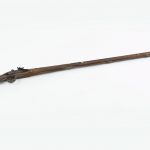1714
Thanadelthur
Thanadelthur was a young Chipewyan woman who, in 1713, was captured and enslaved by a Cree raiding party that had penetrated deep into her people’s traditional lands southeast of Great Slave Lake. Guns were traded to the Cree first, and they used them against their neighbours to keep them away from the Hudson’s Bay Company (HBC) trading post at York Factory and to capture and enslave people during raids.
During the early winter of 1714, Thanadelthur escaped from her Cree captors and, despite starving and enduring frigid temperatures, she reached York Factory. Based on journal entries, her courage and intelligence impressed Governor James Knight. She told of the fine furs her people had and their desire for the Hudson’s Bay Company to build a trading post closer to their territory.
Thanadelthur was asked to guide HBC clerk William Stewart and 150 Cree on a journey northwest from York Factory towards the East Arm of Great Slave Lake. After a long and challenging journey, Thanadelthur found her people. She gave a powerful and persuasive speech, and a negotiated peace between the Cree and the Chipewyan emerged. She also argued for a new trading post near the mouth of the Churchill River which opened in 1717, called Fort Prince of Wales. For almost one hundred years, the new post was the principal source of trade goods for the Chipewyan people of the Northwest Territories. Unfortunately, Thanadelthur didn’t live to see the benefits her courageous journey brought to her people. She returned to York Factory to become Knight’s advisor but fell ill and died at the age of 17 in 1717.
The fixed trading post system, established along the Hudson’s Bay, utilized influential Indigenous intermediaries in the fur trade. Thandelthur’s people, caught in the fur trade without guns, soon learned to work similarly to the Cree and move furs along the northern river systems and across the tundra to the waiting factory ships of the Hudson’s Bay Company.



